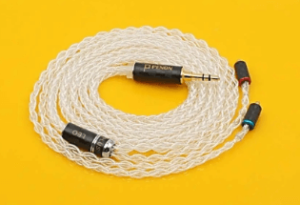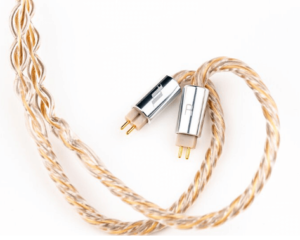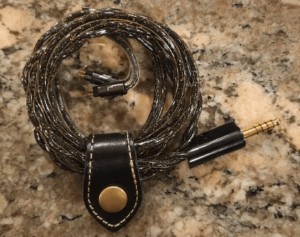IEM cables made from a variety of materials, such as copper or silver, can change the sound of the connected earphones in surprising ways, altering the sound characteristics more closely to your needs.
Best IEM Cables of 2025
These are the best In-ear monitor (IEM) cables of 2025 and have good value, comfort, microphone, lightweight, versatility, and improved sound quality.
1. Penon Impact Cable

The Impacts are somewhat midrange-centric, and in fact their midrange is one of the most impressive of any earphone on the market.
Resolution and soundstage depth are also excellent, and you’ll have no trouble keeping up with the busy music.
Their bass is good by BA standards but lacks the texture and slam of the dynamic drivers, and the treble quality is good, but tuned in a less obtrusive way to avoid listener fatigue.
The Impacts also lack soundstage width compared to some alternative IEMs that cost thousands of dollars.
2. HiFiGo Effect Audio 8W

An 8-wire silver-plated copper counterpart to the pure copper version of the Ares S, the Cadmus shares much of its sibling’s DNA functionally, aesthetically, and even financially.
I was recently able to demo Cadmus 8 as part of the Australian Effect Audio Tour hosted by Damz87.
Although I briefly owned a 4-wire version of this cable last year and struggled to evaluate its value, I thought the wire configuration was to blame.
Silver-plated copper is often used to deliver many of the sonic advantages of silver while avoiding the much higher manufacturing costs. Pure silver line.
Every silver-plated copper cable I have ever owned has produced some degree of an unpleasant tint that can be characterized by the term brittle. It doesn’t have the richness of high-quality sterling silver or the warmth of pure copper.
On the technical side, the same very impressive dynamics and wide soundstage are evident, which seems to be slightly wider than the Ares S 8 with the same resolution improvements.
The bass is very impressive, but the higher high-frequency emphasis makes it less noticeable.
3. Dunu Hulk Cable

The material uses Litz Crystal copper, which has a lower oxygen content and is claimed to provide a cleaner sound (in measured terms, conductivity is increased, but only slightly).
Dunu wanted to note that the Hulk has his hands wrapped, and rightly so. It is set up in a four-strand braid pattern, with each strand containing six groups and each group containing 28 single copper wires. A total of 672 wires are created.
The rest of the cable is pure class from head to toe. It has a carbon fiber barrel with a splitter accented with chrome end plugs.
The slider is a small chrome bead that slides freely over the cable but locks into place when the left and right channels are separated.
There are shrink-wrapped ear guides on top of the connectors, which are very comfortable and have the added bonus of acting as a cable strain relief.
(Note: If you plan to remove the cable guide, leave a few mm as there is no additional strain relief on the connector side.)
The jack points are all at right angles, which I personally prefer. Of course, some people prefer straight jacks, so it would be nice if Dunu offered this option in the future.
This does not seem to be the case since they only need to produce a new adapter and do not need to modify the cable body.
Hulk is an innovative and beautifully designed cable that gives a beautiful finish to any IEM or CIEM setup. They are well-made and look amazing.
And I found the ability to switch adapters to be really practical and far from gimmicky.
This cable eliminates the need for a second cable when switching source devices, and the use of high-quality materials means that the sound quality is lacking compared to other higher-end cables.
4. Penon Leo Plus

Penon sells a wide range of cables covering all kinds of price points, and one model that has been receiving rave reviews around the world over the past few years has been the Leo Plus.
This cable was released just as Effect Audio was making waves in the market with its palladium-powered Leonidas II, and I’ve always wondered if the Leo Plus name was a subtle nod to EA’s success with that model.
I actually bought this cable a long time ago to pair with Andromeda 2020s, which proved to be an excellent match, but Penon has since re-terminated this Leo Plus to 2 pins on the MMCX. I also replaced the old 2.5mm plug with a shiny new 4.4 version.
The Leo Plus is an interesting cable, although it has struggled to keep up with my past memories of its performance compared to some of its more recent competitors.
Ergonomically good and attractive to look at, the Leo Plus proved difficult to pair successfully, although it demonstrated a commendable ability to noticeably widen the soundstage.
5. PWaudio 1960 4-cable

Paying a huge amount of money for this best iem cable is worth it.
PWaudio’s 1960 4-Wire’s black background, treble sparkle, and high level of transparency and resolution are standout features of any pairing, thus giving it a discerning role in the footage you’re watching.
It is essentially a dark atmosphere full of transparent details, whether mid-center or light. It’s an amazing ability to bring even the smallest details to the fore.
I never paid much attention to the effect cables had on the stage. Because most cables are relatively trivial.
6. Liquid Links Martini

Liquid Links is a brand that has recently risen to prominence in the Western earphone industry,
Thanks to its collaboration with Elysian Acoustic Labs, which bundles the critically acclaimed Diva, X, and Annihilator IEMs with Liquid Links cables.
The Martini uses an interesting combination of palladium and gold-plated materials and is without a doubt one of the most beautiful cables in the shootout.
Priced at $349, it’s a natural competitor to Effect Audio’s Eros S, and both cables boast a similar 8-wire girth.
For example, Martini deserves praise for striking a favorable compromise between ergonomics and performance, as it uses smaller wires than the Ares S 8 wires.
This is probably the most attractive IEM cable I’ve ever seen. I’ll gladly admit that that’s what attracted me to this cable in the first place.
These cables are of excellent quality and immediately make the IEMs connected to them feel more expensive.
The Martini may be a bit more difficult to pair than the Cadmus 8 or Ares S 8 in particular, but I think it’s noticeably more comfortable.
7. SilverFi IEM-R4

This is not only the largest stage in terms of size, but also the most airy. It is truly a hologram stage.
Neutral has many interpretations, but at its best, it refers to a balance between frequencies and an accurate tone.
SilverFi house sound has always been the definition of natural. Slightly warm but not too forward midrange and beautiful highs. As with 4-wire, its transparency and resolution are unmatched by any cable below.
So it doesn’t have to be bright to be one of the most detailed, relying on stage and transparency.
When listening to earphones paired with the IEM-R4, the stage is largely determined by the cable, as is the naturalness of the tone.
When you listen to one of these cables, the impact they have on the IEM’s signature is so great that you’re hearing the cable and the IEM as almost equal parts.
Therefore, the differences between items paired with these cables will be smaller, since a significant portion of the sound is due to the cables.
To understand what this means, imagine two settings. One is when it’s a dark night in a rural area far from the city lights and the starry night shines above you. The spotlight is focused on the singer performing for you.
8. Liquid Link Venom

Liquid Links is not a “household name” among Western IEM enthusiasts. Some older cable brands do. But if any of the cables are going to change, it should definitely be Venom.
My friend Lycos kindly lent it to me. It’s his for this shootout.
Utilizing a genuine Pentaconn OFC 4.4mm plug and alloy combination for a very unique appearance, the Venom is Liquid Links’ flagship model.
Those new to the hobby may be shocked to learn that $1089 is relatively inexpensive by flagship cable standards, at least when compared to products from boutique brands like Effect Audio, PW Audio & Eletech.
This probably makes Venom an ideal first purchase for anyone looking to dip their toes into the flagship cable waters and want to see just how much extra performance is possible when money isn’t the limiting factor.
Venom is an interesting proposition on several fronts. Not only is it visually unique, the ergonomics are surprisingly smooth for such a heavy cable, but it’s not completely problem-free.
There is no doubt about the performance of the Venom and it is probably the best cable for enhancing IEM technologies, especially resolution and imaging. If you look at the price tag, you won’t be surprised.
Where the Venom lags behind most copper cables is in the tonal range. Using the wrong IEM can make you feel a little cold or impersonal. But when the pairing is good, it tends to be very good.
9. Effects Audio Code 23

The Effects Audio Code 23 is a beast of a cable in the truest sense of the word. I was recently able to demo Code 23 as part of the Australian Effect Audio Tour hosted by Damz87.
Branded “perhaps the world’s thickest IEM cable” and the first IEM cable I can remember using solid core copper wire (as opposed to the more common stranded wire),
it’s a product that even Effect Audio admits has a very niche market. appeal.
At $599, it takes up an interesting amount of space. They’re expensive enough to disappoint casual IEM users, but not at a price that suggests flagship status by premium earphone cable standards.
However, flagship performance is almost implied by the use of the name “Code”, which EA previously assigned to its higher-end models.
It wouldn’t be easy to create a buzz in the earphone world with something as innocuous as a wire. But Code23 has definitely caught people’s mouths and you’ll find out what one of them has to say about it.
Code 23 is a difficult cable to recommend, but if you’re interested in IEM cables, I highly recommend giving it a try purely to sample the performance this solid-core copper can deliver!
Who knows, maybe you don’t care about ergonomics as much as I do. It’s hard, then, to label a $599 IEM cable “great value,” but from a pure performance standpoint the Code 23 is very good compared to much more expensive options from premium manufacturers.
Do upgrade cables actually work?
There are a wide variety of cables available at a variety of price points, most costing from at least $100 to $2500, some even more.
However, there is still little information about the general performance of cables, especially how this steadily increases across different price points. Of course, this may be due to continued cable skepticism across the West.
The majority of people in the US and Europe don’t trust cable, and this is reflected in the sites we come across, like Head-Fi.org. So investing more than $300 requires a big leap of faith.
Absolutely, especially since there are very few places to demo cables.
So I imagine that people will either pick up a $100 cable or experiment with switching out stock cables, even when they are tentatively interested in trying a cable but are understandably still hesitant.
As a result, they end up wasting their precious money because they didn’t hear the difference. Let me tell you now, it is extremely difficult, even for a trained ear, to analyze and compare cheap cables.
The quality of the material makes the extensions poorer, making the notes more vague and more difficult to compare, and in most cases, manufacturers use very similar copper or SPC wire.
Our worldview is determined by the culture we live in and shaped by the people around us. In East Asia, the situation has reversed.
Looking at Asian forums such as andaudio.com or erji.net, the general consensus is that the cable plays a role in determining signature or performance aspects, and there is little debate on the matter.
So more people think it’s worth investing in an upgrade cable.
The difference can be explained, at least in part, by the fact that cities like Tokyo, Hong Kong, and Singapore have developed into major audio hotspots with extensive demonstrations of all equipment, including cable.
However, although speculative, one could also consider the characteristics of the types of music people listen to in different cultures,
such as range, pitch, flow, and rhythm (Born & Hesmondhalgh, 2000), as well as innate biological and cultural differences.
For example, Asian voices tend to have slightly higher pitches and different rhythms (e.g., Brunelle & Kirby, 2016; Ohara, 1999).
Considering that one of the most fundamental improvements in advanced cables is the impact on top frequencies due to the nature of the wire (lower quality and stronger top frequency roll), a connection with sensitivity to higher pitches is again a guess, but not unthinkable.
Also, read: Penon Globe IEM Review 2025
